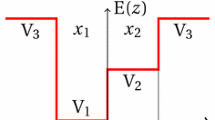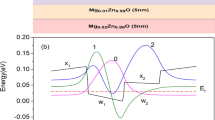Abstract
The conduction electron states in step-like strained GaAs/InGaAs quantum wells are theoretically investigated under the effective mass approximation, taking into account the effects of band non-parabolicity. With such information, the intersubband three-level Raman gain is calculated looking to reveal a possible application of the studied systems as sources for THz Raman lasing. A group of high-gain intersubband transitions is identified, and the results are strongly dependent on a suitable geometric design in terms of potential well widths which can lead to values of the Raman gain between 200 and \(400\,\hbox {cm}^{-1}\), the latter values being close to those previously reported in GaAs-based double asymmetric quantum wells. Secondary radiation frequencies are identified within the range of few tens of THz. It is found that the influence of band non-parabolicity causes a significant reduction of the Raman gain, in comparison with the values obtained neglecting such a phenomenon. Therefore, conduction-band non-parabolicity becomes a crucial element for the accurate quantitative description of the intersubband-related optical response in low-dimensional heterostructures involving small gap materials.







Similar content being viewed by others
References
E. Rosencher, P. Bois, J. Nagle, S. Delaitre, Second harmonic generation by intersubband transitions in compositionally asymmetrical MQWs. Electron. Lett. 25, 1063–1065 (1989)
E. Rosencher, P. Bois, Model system for optical nonlinearities: asymmetric quantum wells. Phys. Rev. B 44, 11315–11327 (1991)
H.C. Liu, J. Li, E. Costard, E. Rosencher, J. Nagle, Sum frequency generation by intersubband transition in step quantum wells. Solid State Electron. 40, 567–570 (1996)
A. D’Andrea, N. Tomassini, L. Ferrari, M. Righini, S. Selci, M.R. Bruni, D. Schiumarini, M.G. Simeone, Optical properties of stepped \(\text{ In }_x\text{ Ga }_{1-x}\text{ As }/\text{ GaAs }\) quantum wells. Microelectron. Eng. 43–44, 259–263 (1998)
X. Chen, On the role of local-field effect on optical intersubband saturation and intrinsic bistability in a step quantum well. Sol. State Commun. 104, 125–130 (1997)
T.W. Kim, Enhancement of the intersubband Stark effectin strained \(\text{ In }_{x}\text{ Ga }_{1-x}\text{ As/In }_{y}\text{ Al }_{1-y}\text{ As }\) asymmetric step quantum wells. Appl. Surf. Sci. 125, 213–216 (1998)
W. Wu, Tunable mid-infrared photodetectors employing Stark shifts of intersubband transitions in \(\text{ In }_{0.05}\text{ Ga }_{0.95}/\text{ Al }_{0.32}\text{ Ga }_{0.68}\text{ As }/\text{ Al }_{0.45}\text{ Ga }_{0.55}\text{ As }\) asymmetric step quantum wells. Superlatt. Microstruct. 35, 25–34 (2004)
M.G. Barseghyan, A.A. Kirakosyan, Electronic states in a step quantum well in a magnetic field. Physica E 28, 471–481 (2005)
L.A. Ferrer-Moreno, R. Betancourt-Riera, R. Betancourt-Riera, R. Riera, Electron Raman scattering in semiconductor step-quantum well. Phys. B 477, 87–93 (2015)
R. Betancourt-Riera, R. Betancourt-Riera, L.A. Ferrer-Moreno, J.M. Nieto-Jalil, Electron states and electron Raman scattering in semiconductor step-quantum well: electric field effect. Superlatt. Microstruct. 104, 428–437 (2017)
H. Dakhlaoui, Tunability of the optical absorption and refractive index changes in step-like and parabolic quantum wells under external electric field. Optik 168, 416–423 (2018)
A. Samyh, W. Salhi, A. Rajira, H. Akabli, A. Abounadi, A. Almaggoussi, Double two-photon absorption in an asymmetric stepped quantum well in the terahertz range. Superlatt. Microstruct. 130, 560–568 (2019)
S. Offsey, W.J. Schaff, L.F. Lester, L.F. Eastman, S.K. McKernan, Strained-layer InGaAs–GaAs–AlGaAs lasers grown by molecular beam epitaxy for high-speed modulation. IEEE J. Quant. Electron. 37, 1455–1462 (1961)
I. Nevinskas, R. Butkuté, S. Stanionytė, A. Bičiūnas, A. Geižutis, A. Krotkus, THz pulse emission from InAs-based epitaxial structures grown on InP substrates. Semicond. Sci. Technol. 31, 115021 (2016)
M.A. Kozub, M. Motyka, M. Dyksik, G. SȩK, J. Misiewicz, K. Nishisaka, T. Maemoto, S. Sasa, Non-destructive carrier concentration determination in InAs thin films for THz radiation generating devices suing fast differential reflectance spectroscopy. Opt. Quant. Electron. 48, 384 (2016)
Z. Qiao, X. Li, H. Wang, T. Li, X. Gao, Y. Qu, B. Bo, C. Liu, High-performance 1.06\(\mu \)m InGaAs/GaAs double quantum well semiconductor laser with asymmetric heterostructure layers. Semicond. Sci. Technol. 34, 055013 (2019)
M.A. Billaha, M.K. Das, Peformance analysis of AlGaAs/GaAs/InGaAs-based asymmetric long-wavelength QWIP. Appl. Phys. A 125, 457 (2019)
G. Sun, J.B. Khurgin, L. Friedman, R.A. Soref, Tunable intersubband Raman laser in GaAs/AlGaAs multiple quantum wells. J. Opt. Soc. Am. B 15, 648–651 (1998)
G. Sun, J.B. Khurgin, R.A. Soref, Design of a GaN/AlGaN intersubband Raman laser electrically tunable over the \(3\,-\,5\;\mu \)m atmospheric transmission window. J. Appl. Phys. 99, 033103 (6 pages) (2006)
C.G. Van de Walle, Band lineups and deformation potentials in the model-solid theory. Phys. Rev. B 39, 1871–1883 (1989)
J. Minch, S.H. Park, T. Keating, S.L. Chuang, Theory and experiment of \(\text{ In }_{1-x}\text{ Ga }_x\text{ As }_y\text{ P }_{1-y}\) and \(\text{ In }_{1-x-y}\text{ Ga }_x/\text{ Al }_y\text{ As }\) long-wavelength strained quantum-well lasers IEEE. J. Quant. Electron. 35, 771 (1999)
J. Shao, A. Dörnen, R. Winterhoff, F. Scholz, Ordering parameter and band-offset determination for ordered \(\text{ Ga }_x\text{ In }_{1-x}\text{ P }/(\text{ Al }_{0.66}\text{ Ga }_{0.34})\text{ In }_{1-y}\text{ P }\) quantum wells. Phys. Rev. B 66, 035109 (2002)
K. Köksal, M. Şahin, The effect of dilute nitrogen on nonlinear optical properties of the InGaAsN/GaAs single quantum wells. Eur. Phys. J. B 85, 333 (2012)
A. Tiutiunnyk, C.A. Duque, M.E. Mora-Ramos, Intersubband Raman gain in strained zincblende III-nitride-based step asymmetric quantum wells: non-parabolicity effects. Opt. Quant. Electron. 50, 234 (2018)
P.A. Khomyakov, M. Luisier, A. Schenk, Compositional bowing of band energies and their deformation potentials in strained InGaAs ternary alloys: a first-principles study. Appl. Phys. Lett. 107, 062104 (2015)
E.O. Kane, Band structure of Indium Antimonide. J. Phys. Chem. Solids 1, 249–261 (1957)
Q.H.F. Vrehen, Interband magneto-optical absorption in Gallium Arsenide. J. Phys. Chem. Solids 29, 129–141 (1968)
V.G. Golubev, V.I. Ivanov-Omskii, I.G. Minervin, A.V. Osutin, D.G. Polyakov, Nonparabolicity and anisotropy of the electron energy spectrum in GaAs. Sov. Phys. JETP 61, 1214–1219 (1985)
S. Chaudhuri, K.K. Bajaj, Effect of nonparabolicity on the energy levels of hydrogenic donors in \(\text{ GaAs-Ga }_{1-x}\text{ Al }_x\text{ As }\) quantum-well structures. Phys. Rev. B 29, 1803–1806 (1984)
F. Malcher, G. Lommer, U. Rössler, Electron states in \(\text{ GaAs }/\text{ Ga }_{1-x}\text{ Al }_x\text{ As }\) heterostructures: nonparabolicity and spin-splitting. Superlatt. Microstruct. 2, 267–272 (1986)
D.F. Nelson, R.C. Miller, D.A. Kleinman, Band nonparabolicity effects in semiconductor quantum wells. Phys. Rev. B 14, 7770–7773 (1987)
U. Eckenberg, Nonparabolicity effects in a quantum well: sublevel shift, parallel mass, and Landau levels. Phys. Rev. B 40, 7714–7726 (1989)
B.R. Nag, S. Mukhopadhyay, Energy levels in quantum wells of nonparabolic semiconductors. Phys. Stat. Sol. B 175, 103–112 (1993)
C. Sirtori, F. Capasso, J. Faist, S. Scandolo, Nonparabolicity and a sum rule associated with bound-to-bound and bound-to-continuum intersubband transitions in quantum wells. Phys. Rev. B 50, 8663 (1994)
C. Wetzel, R. Winkler, M. Drechsler, B.K. Meyer, U. Rössler, J. Scriba, J.P. Kotthaus, V. Härle, F. Scholz, Electron effective mass and nonparabolicity in \(\text{ Ga }_{0.47}\text{ In }_{0.53}\text{ As }/\text{ InP }\) quantum wells. Phys. Rev. B 53, 1038–1041 (1996)
Y. Li, O. Voskoboynikov, C.P. Lee, S.M. Sze, Energy and coordinate dependent effective mass and confined electron states in quantum dots. Sol. State. Commun. 120, 79–83 (2001)
K.Q. Le, Finite element analsysis of quantum states in layered quantum semiocnductor structures with band nonparabolicity effect. Microw. Opt. Technol. Lett. 51, 1–5 (2009)
S. Panda, B.K. Panda, Effect of conduction band nonparabolicity on the optical properties in a single quantum well under hydrostatic pressure and electric field. Pramana-J. Phys. 78, 827–833 (2012)
N. Kotera, Energy dependence of electron effective mass and effect of wave function confinement in a nanoscale \(\text{ In }_{0.53}\text{ Ga }_{0.47}\text{ As }/\text{ In }_{0.52}\text{ Al }_{0.48}\text{ As }\) quantum well. J. Appl. Phys. 113, 234314 (2013)
N. Voković, V. Milanović, J. Radovanović, Influence of nonparabolicity on electronic structure of quantum cascade laser. Phys. Lett. A 378, 2222 (2014)
A. Persson, R.M. Cohen, Reformulated Hamiltonian for nonparabolic bands in semiconductor quantum wells. Phys. Rev. B 38, 5568–5575 (1988)
S. Tsu**o, Optical gain of two-dimensional hole gas by intersubband Raman transitions. J. Appl. Phys. 112, 023508 (2012)
A. Tiutiunnyk, M.E. Mora-Ramos, C.M. Duque, R.L. Restrepo, F. Ungan, J.C. Martínez-Orozco, E. Kasapoglu, C.A. Duque, Electron Raman scattering in a double quantum well tunes by an external nonresonant intense laser field. Opt. Mat. 64, 496–501 (2017)
Y. Shen, The Principles on Nonlinear Optics (Wiley, New York, 1984), pp. 143–151
S.M. Maung, S. Katayama, Theory of intersubband Raman laser in modulation-doped asymmetric coupled double quantum wells. J. Phys. Soc. Jpn. 73, 2562–2570 (2004)
S.M. Maung, S. Katayama, Gain of intersubband Raman lasing in modulation-doped asymmetric coupled double quantum wells. Physica E 21, 774–778 (2004)
R. Betancourt-Riera, R. Rosas, I. Marín-Enriquez, R. Riera, J.L. Marín, Electron Raman scattering in asymmetrical multiple quantum wells. J. Phys. Condens. Mater. 17, 4451–4461 (2005)
M. Miura, S. Katayama, Electric-field effects on intersubband Raman laser gain in modulation-doped GaAs/AlGaAs coupled double quantum wells. Sci. Technol. Adv. Mat. 7, 286–289 (2006)
R. Betancourt-Riera, R. Betancourt-Riera, L.A. Ferrer-Moreno, A.D. Sañu-Ginarte, Electron states and electron Raman scattering in a semiconductor quantum well with step-barriers: electric field effect. Phys. B 575, 411700 (2019)
N.N. Moorthy, A. John Peter, C.W. Lee, Raman gain in a Boron based Group-III nitride quantum well. Superlatt. Microstruct. 70, 13–23 (2014)
N.N. Moorthy, A. John Peter, Intraband Raman laser gain in a boron nitride coupled quantum well. AIP Conf. Proc. 1731, 120009 (2016)
Acknowledgements
AT acknowledges the financial support from Postdoctoral Fellowship FONDECYT 3180276. DL acknowledges partial financial support from Centers of excellence with BASAL/CONICYT financing, Grant FB0807, CEDENNA and FONDECYT 1180905. CAD acknowledges the financial support from El Patrimonio Autónomo Fondo Nacional de Financiamiento para la Ciencia, la Tecnología y la Innovación Francisco José de Caldas (project 80740-173-2019).
Author information
Authors and Affiliations
Corresponding author
Ethics declarations
Conflict of interest
The authors declare that they have no conflict of interest.
Additional information
Publisher's Note
Springer Nature remains neutral with regard to jurisdictional claims in published maps and institutional affiliations.
About this article
Cite this article
Tiutiunnyk, A., Pérez-Quintana, I., Laroze, D. et al. Influence of conduction-band non-parabolicity on terahertz intersubband Raman gain in GaAs/InGaAs step asymmetric quantum wells. Appl. Phys. A 126, 23 (2020). https://doi.org/10.1007/s00339-019-3214-4
Received:
Accepted:
Published:
DOI: https://doi.org/10.1007/s00339-019-3214-4




